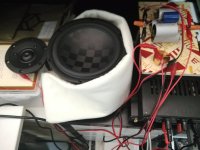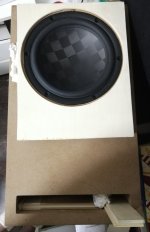There are many people who would say that harmonic distortion is not really audible, depends of which hifi temple you worship. But obviously there must be a limit on how low you can go before it falls apart from tweeter clipping etc. What are your thoughts on this? Have you tried pushing it even lower, maybe under situation where you do not intent to play it loud? Bedroom speakers for example... Or maybe multiple tweeters similar to line array? So some tweeters play say 700Hz to 3kHz. And one go from 700Hz to 20kHz. Obviously can't use an expensive tweeter... Just like to hear your opinionThere is definitely a tradeoff and a balancing of performance priorities. Certainly, any tweeter benefits from a higher filter crossover than a lower one. But the flip side of that coin is the performance of the midrange driver going ever higher.
I have found that a tweeter can be crossed based on the following criteria:
(1) Based on Fs and filter level: For 2nd order filters 4 x Fs, for 3rd order filters 3 x Fs, for 4th order filters 2 x Fs. The idea is that the electrical drive signal should be about -20 dB down at Fs.
(2) Based on the point where the 2nd Harmonic Distortion reaches -40 dB (1%)
(3) Based on the point where 3rd Harmonic Distortion level reaches -50 dB (0.3%)
I also agree that midrange produced by tweeters sound nicer than midrange produced by midwoofers. A compromise that I tend to go for is a good 3" full range and cross it at 500Hz... YMMV. Something in the full range forum known as WAW/FAST.
Oon
Yes, there are many people who would say that. I think that 2nd HD is pretty unimportant. But 3rd order is more audible and more annoying. I think there is a difference between the point where distortion becomes audible and the point where it becomes annoying. In other words, at some point, distortion becomes so intrusive that we become aware of it as a distinct audible phenomenon. But at a lower level we are not consciously aware of it, but it may still cause listening fatigue and annoyance.There are many people who would say that harmonic distortion is not really audible,
To me, the true importance of low harmonic distortion is that HD is an indicator for many other types of distortions which are more difficult to measure and quantify.
I have not tried pushing the tweeter bandwidth lower than my guidelines. I am fearful of pushing a lot of current through a tweeter voice coil near the Fs. As I said, I like to see the electrical filter response at about -20 dB at resonance.
Jim, did you noticed a smoothed or less clear sound swapping SB cac to 16 Txn, please ?
I was said in the mid band Txn was a little less snappy than said Revelator for instance. Any experience ? Wonder if the Txn tweeter often assiociated could be the reason of this ?
I was said in the mid band Txn was a little less snappy than said Revelator for instance. Any experience ? Wonder if the Txn tweeter often assiociated could be the reason of this ?
Jim, did you noticed a smoothed or less clear sound swapping SB cac to 16 Txn, please ?
Here is a detailed subjective assessment of the two systems.
post #118 https://www.diyaudio.com/community/threads/new-active-satori-textreme.366347/page-6#post-6543808
Keep in mind that the two systems share the same 12" woofer, the same amps, nearly identical baffle shap, and the overall frequency balance (EQ) is very similar. What is different is that the first system uses SB17CAC35 as a midrange and an SB26CDC as a tweeter. The second system, uses MW16TX as a midrange and TW29TXN-B as a tweeter. So I am assessing the subjective difference in both midrange and tweeter. It is hard to assign a sound difference to a particular driver. It is the combination I was comparing.
j.
Just hard to find tweeters that cross low and perform well high up. Can only think of twoThere are many people who would say that harmonic distortion is not really audible, depends of which hifi temple you worship. But obviously there m
I also agree that midrange produced by tweeters sound nicer than midrange produced by midwoofers.
Just hard to find tweeters that cross low and perform well high up. Can only think of two
Not saying some use too much high diameter mid as well ! Is this words still true if you marriage a 5" with a 1" around 2k to 2k5 hz ?!
The Bliesma tweeters stand out, T34B, T34S, and T34A. They have really good high frequency performance (especially the B), and the low frequency performance is exceptional. Really no other direct radiator tweeter can do these do in the range from 1k - 2k...ust hard to find tweeters that cross low and perform well high up. Can only think of two
There are several tweeters that have great low frequency performance, but just not quite as good as the Bliesma. The Morel ET338 and MDT32S. Satori TW29TXN-B, TW29DN and others of the TW29 series. SB29SDAC is a good one at the lower price range. ScanSpeak has quite a few... D2905/9700, D2905/9900, D2904/7100, D2904/71400 and more.
So I can think of more than two...
My mistake, there is no T34SThe Bliesma tweeters stand out, T34B, T34S, and T34A.
On the Bliesma website (and at Solen the north american distributor), only the T34A (aluminum) and T34B (berylium) are listed.
Having lucked into a pair of TW29R at 25% off, I then went for broke and "fished" the MW19TX-8 at 35% off. (Whereas during the Covid years I stayed frugal and DIYed mainly $1-200 speakers, such as 5" honeycomb+AMT 7L TL.) Early this morning I had a few hours before a short trip to Qingdao (I'm on the train now), so played with the drivers and XO.
First I was pleasantly surprised that (judging by ear while playing tone sweep) the Textreme only had a small <3dB bump at 5khz (and then at ~12khz), and only exactly on-axis. This is flatter than nearly all my fullrange drivers. So the MW19TX-8 could be used by itself with a basic notch filter (0.47mH || 4.7uF) or simply slightly off-axis. I then added the ring tweeter 2-way 1st-order parallel (0.68mH LPF; 14.8uF HPF), and lastly 1st-order series (0.68mH, 21.6uF) XO at ~1.9khz. To my ears flat on-axis 850-10500hz (other than 2-4khz natural loudness curve). Played string music pretty nice. Except low bass -- tested without cabinet/baffle (wool scarf wrapped around back of driver). Not yet settled on the tweeter faceplate offset from midwoofer's to try to align acoustic centers; does anyone know?
After my short trip I will try testing the midwoofer in my general-purpose 8" 17L 1.5m TLonken, somehow.
(XO parts are from my Jantzen DIY-reuse coils and caps.)
First I was pleasantly surprised that (judging by ear while playing tone sweep) the Textreme only had a small <3dB bump at 5khz (and then at ~12khz), and only exactly on-axis. This is flatter than nearly all my fullrange drivers. So the MW19TX-8 could be used by itself with a basic notch filter (0.47mH || 4.7uF) or simply slightly off-axis. I then added the ring tweeter 2-way 1st-order parallel (0.68mH LPF; 14.8uF HPF), and lastly 1st-order series (0.68mH, 21.6uF) XO at ~1.9khz. To my ears flat on-axis 850-10500hz (other than 2-4khz natural loudness curve). Played string music pretty nice. Except low bass -- tested without cabinet/baffle (wool scarf wrapped around back of driver). Not yet settled on the tweeter faceplate offset from midwoofer's to try to align acoustic centers; does anyone know?
After my short trip I will try testing the midwoofer in my general-purpose 8" 17L 1.5m TLonken, somehow.
(XO parts are from my Jantzen DIY-reuse coils and caps.)
Attachments
Last edited:
I managed to test the MW19TX-8 "over" my second 17L 1.5m TLonken that hosted an 8" plus topside Wavecor 045 tweeter. (Tapered line cross-section from ~11.5cm to ~2.1cm yielding effective length ~2m by MJK and QW frequency ~43hz which was confirmed by ear using the Textreme.) Baffle-step dip ~315 but the TL effectively augmented the driver response 85-180 so it sounded flat. Below 85 the TL exceeded the driver's direct output, filling in nicely the 60s valley in the FR chart. The 50s dropped quickly i.e. a bit light weight.
Like the Mark Audio MAOP5/Alpair10 mentioned in another post, these are new drivers. The first time through my test suite (organ, piano, double bass etc.) the lowest notes were weak. The second round was much much better! Low bass came alive.
As for the Mark Audio 5&10, I'd say they sounded "reserved" especially at frequency extremes -- a bit like ceramic-on-aluminum. Maybe that's the price of extreme resolving power (yes) or maybe just too new.
Like the Mark Audio MAOP5/Alpair10 mentioned in another post, these are new drivers. The first time through my test suite (organ, piano, double bass etc.) the lowest notes were weak. The second round was much much better! Low bass came alive.
As for the Mark Audio 5&10, I'd say they sounded "reserved" especially at frequency extremes -- a bit like ceramic-on-aluminum. Maybe that's the price of extreme resolving power (yes) or maybe just too new.
Attachments
Last edited:
addendum: I think the TL contributes three ways: (1) classic backwave phase-shift, 113hz (3m) delayed 1.5m becomes 0deg in-phase +6dB, 57hz (6m) and 170hz (2m) become +/- 90deg +3dB, constructive over the range 37-187hz (1.5m*6 to 1.5m*1.2); (2) MJK quarterwave resonance multiplier effect for R:1-tapered line R^1/4.75 (my redux) here ~1.4*1.5m ~43hz; (3) other, weaker resonances from sections of the line delimited by ends, folds and bends. They can actually be heard.
Guys, why no interest in the SB Textreme MW? (Apart from trying to unload them; search "Textreme".) I'm a bit stumped by the 40-60hz "ravine", to my ears much deeper than the published chart's ~6dB. I now think 50hz is really missing and I can't find any frank discussions of this issue, nor in-speaker measurements where it is resolved. Above 60hz my MW19TX-8 resolves everything amazingly well; mid-40hz actually okay. Suggestions anyone?
@wchang The dip at 60hz on almost all SB charts has been reported to be an effect of their measurement room or speaker mount they use. I have a WO24P-4 and do not see this effect in my speaker box. I do have other effects due to my room though.
I am not sure what you mean by this. Could you explain your thoughts a little more?Guys, why no interest in the SB Textreme MW? (Apart from trying to unload them; search "Textreme".)
- Home
- Loudspeakers
- Multi-Way
- SB Acoustics Textreme

